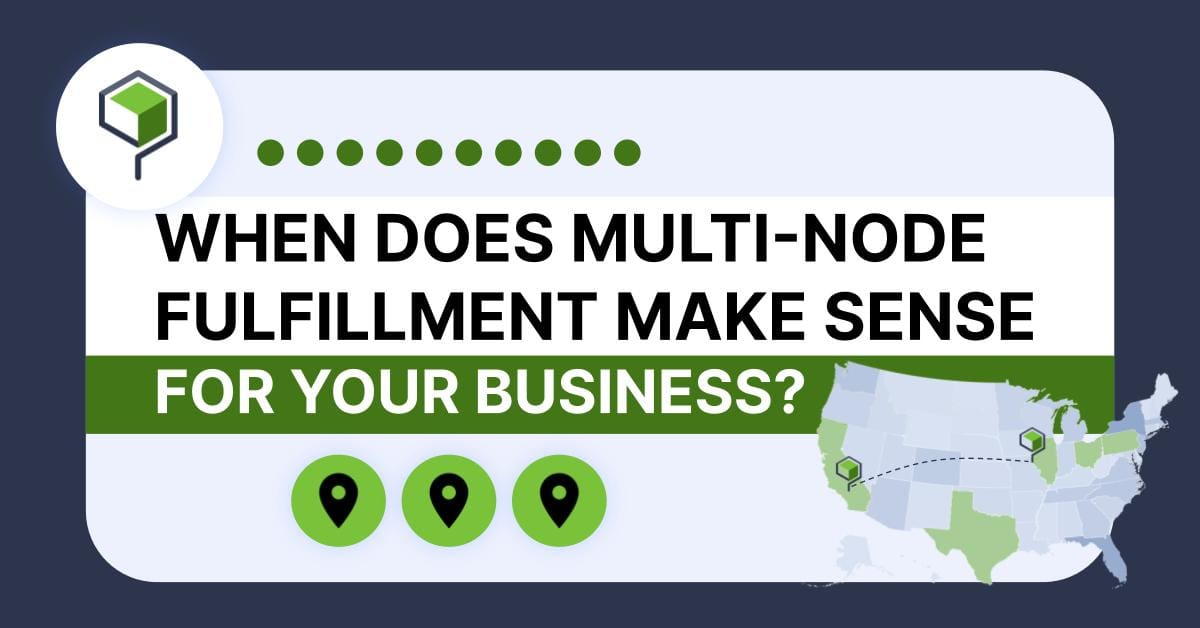When Does Multi-node Fulfillment Make Sense for Your Business?

eCommerce brands are having a tough job keeping pace with shifting customer expectations surrounding shipping and delivery. Today’s online shoppers demand near-instant gratification after they hit ‘purchase’. According to ECDB, consumers were willing to wait an average of just 2.15 days in 2023 for orders to arrive, compared with 2.36 days in 2022.
In sum, free or low-cost shipping and rapid delivery have become the table stakes to secure a conversion from first-time customers.
The problem? The infrastructure supplied by many centralized or single-node fulfillment centers struggles to meet these new requirements. Common challenges in single-node fulfillment include escalating shipping costs, difficulty meeting faster delivery timeframes, and a lack of flexibility when it comes to volatile demand.
If any of these pain points sound familiar to you, it may be time to embrace a multi-node fulfillment strategy.
But what is multi-node fulfillment, and how does it enable eCommerce brands to stay competitive in an increasingly saturated marketplace?
What is multi-node fulfillment?
Multi-node fulfillment is a decentralized fulfillment strategy where businesses store inventory and fulfill orders using multiple facilities or ‘nodes’. A node refers to any facility that’s capable of handling the fulfillment and shipping of customer orders, allowing orders to be allocated to any of those locations as needed. This differs from a single node or centralized fulfillment approach, where only one fulfillment center or warehouse is in use.
How does multi-node fulfillment work?
In a multi-node fulfillment strategy, each fulfillment ‘node’ within the network is set up with independent fulfillment and storage capabilities. When a customer order is placed, routing systems will determine which node is most appropriate to fulfill and ship that individual order. Criteria used to determine optimal order routing include:
- Available SKUs
- Fulfillment lead time
- Shipping costs
- Delivery timeframe
- Carbon emissions
Size, location, and proximity to transportation networks are extremely important when selecting fulfillment nodes. A node that’s located near an area with a high density of customers, for example, allows you to lower shipping costs and delivery timeframes for a substantial portion of orders.
The benefits of multi-node fulfillment
Faster, cheaper shipping
A network of strategically selected nodes enables businesses to bring order fulfillment closer to their end customers, shortening shipping timeframes and lowering the number of zones a package must cross to reach its destination. For example, a multi-node order routing strategy could prioritize allocating orders to the facility that’s the fewest number of zones away from the customer, guaranteeing the quickest and most cost-effective delivery method.
Ease of scaling
High-growth brands can avoid growing pains by leveraging multiple locations to fulfill orders, rather than maxing out one facility and needing to find another at short notice. Multi-node fulfillment makes it possible to leverage additional space across several facilities as order volumes increase and to continuously adjust this allocation in line with market trends or peak season activity.
Better operational resilience
Using more than one facility is one of the best ways to future-proof your operation against disruption. Power outages, adverse weather, or illness all have to potential to bring order fulfillment to a standstill during critical periods, which risks damaging your brand’s reputation as a reliable vendor. Being able to route orders to other facilities during times of operation strain helps to avoid bottlenecks and ensure that all customers receive their orders on time.
Is multi-node fulfillment a good fit for my business?
There are several scenarios where a multi-node distribution strategy can make eCommerce more responsive and cost-efficient, such as:
My customer base is widely distributed across different regions
When your customers are spread from coast to coast, it’s difficult to standardize delivery timeframes and costs. While some customers might be located close to your facility and eligible for short-haul delivery services, others may require much more costly methods to achieve that coveted two-day delivery timeframe. Utilizing multiple fulfillment centers in key regions allows you to reach all of your customers within a two-day delivery window, which offers a significant competitive advantage.
My order volumes are rising fast.
Managing high order volumes in a single facility can leave your business vulnerable to bottlenecks in the fulfillment process, especially during periods of peak demand like the holiday season. Distributing this order volume between different facilities gives you plenty of room to scale without sacrificing streamlined order processing.
My customer’s tastes differ between regions.
Customers in different parts of the country may develop different purchasing habits based on factors like climate, culture, or local trends. When you have only one facility, it can be difficult to optimize your storage strategy and picking locations to suit these regional variations. By leveraging multiple facilities, it’s possible to customize each fulfillment node according to the demand and tastes of the customers it serves. This helps to minimize excess inventory through a tighter assortment of SKUs and tailored picking strategies.
When is multi-node fulfillment NOT the right approach?
Although it may seem like the gold standard of eCommerce fulfillment, not every business benefits equally from implementing a multi-node fulfillment network. In fact, there are some cases where multi-node fulfillment can result in increased costs without any improved operational efficiency, such as:
My order volumes are low or unpredictable.
If you’re a fledgling business that’s building out a stable customer base, your order volumes may not be consistently high enough to benefit from bringing another facility online. Moreover, it might be too early to make data-driven decisions on where additional fulfillment centers should be located to maximize delivery speed or shipment costs.
My customers are concentrated in one city/region.
If your customers aren’t distributed across a large geographic area, you’re less likely to reap the benefits of a multi-node distribution strategy. Allocating orders to other facilities for fulfillment may result in increased delivery costs, especially if subsequent facilities end up being further away from where your customers are based or less well-connected to transportation networks.
I sell lots of customizable goods.
If you sell products with a lot of customization options or product variations, managing inventory that needs to be distributed across multiple nodes can be time-consuming and difficult. The need to monitor how SKU variations are distributed and where raw materials or specialized machinery for customization are stored can mean that multi-node fulfillment causes more issues than it solves.
How to plan a successful multi-node fulfillment strategy
Decide whether multi-node fulfillment is right for you. The scenarios listed above will help you to determine whether your business is likely to benefit from a multi-node strategy. Other factors to consider are order volume and volatility, current shipping cost per order, and growth forecasts.
Choosing the right nodes. The success of multi-node fulfillment rests on choosing the strategic locations for additional fulfillment centers. The biggest criteria to consider are the locations of key customer hubs, regional growth forecasts, shipping carrier availability, and transportation networks. Moreover, the distance between nodes should be carefully considered to maximize short-haul shipping coverage.
Inventory allocation. Storing inventory in more than one place means that your business will need to determine the optimal inventory allocation for each node. This means taking into account your forecast demand, local customer behavior, and the requirements of individual SKUs to formulate the appropriate storage strategy.
Partner with ShippingTree for streamlined multi-node fulfillment
There’s no doubt that multi-node fulfillment can pay dividends to businesses that need to scale seamlessly and lower their operational costs. However, implementing this strategy is complex and requires advanced planning and logistics expertise. Considerations like inventory allocation and node selection are critical to ensure that your fulfillment operation can expand without headaches.
Working with a tech-enabled 3PL like ShippingTree brings an intuitive approach to multi-node fulfillment, backed by user-friendly software that offers full visibility into your operation across locations. With available nodes in Columbus, OH, and Los Angeles, ShippingTree can enable two-day and even same-day delivery speeds with ease while providing seamless omnichannel support. Contact us today to find out how ShippingTree can make multi-node fulfillment a reality.



